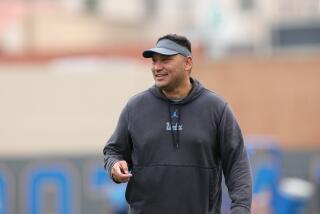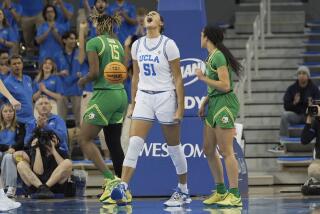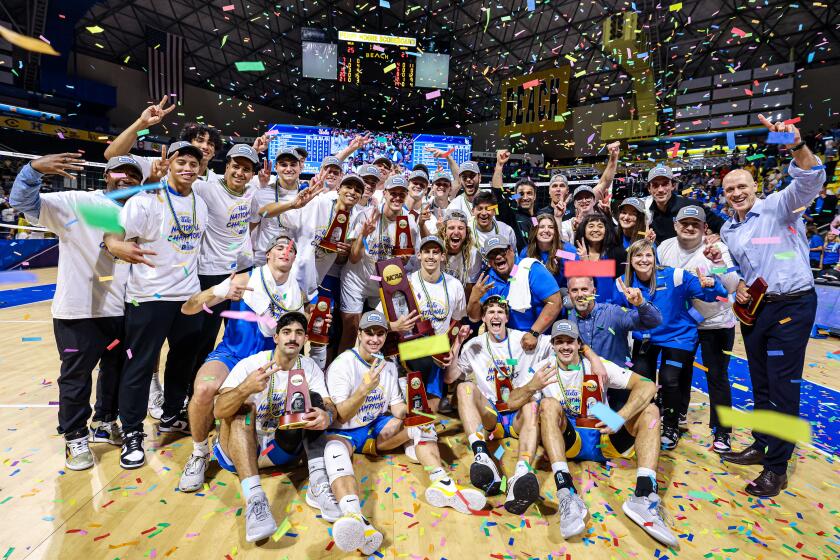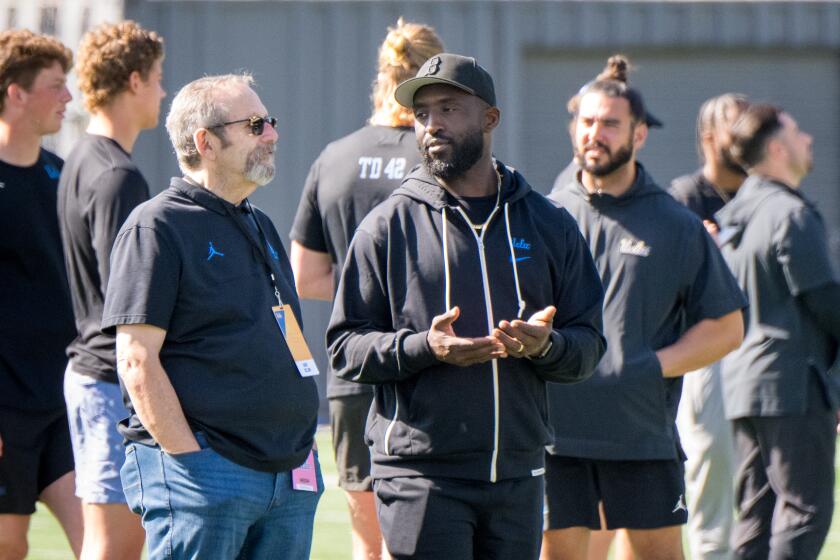UCLA knows that in Pac-12, the defense can’t rest
Mike Bellotti, former head coach at Oregon, can pick out the defensive coordinator on any Pac-12 Conference football staff.
“They have a very high stress rate and a lot of gray hairs,” Bellotti said.
The reason is clear: In 2004, there were 29 major college teams that averaged 30 or more points per game. Now there are 62.
The challenge is especially difficult in the Pac-12, where a smorgasbord of offenses ranges from the tempo-obsessed spreads to the traditional meat-grinder approach.
UCLA will complete a tour of the extremes on Saturday, facing vapor trail-making Oregon a week after knocking heads with Stanford’s battering ram.
“It’s a defensive coordinator’s nightmare in the Pac-12,” Bellotti said. “What worked the previous week might not work against the next team. Even the spread teams have different aspects for how they want to make you line up or make the wrong decision or cover the wrong guy.”
Lou Spanos handles getting those things right at UCLA. “You have to be creative,” said Spanos, who is in his second season with the Bruins. “Each week there is a new dynamic to deal with.”
Those dynamics have changed the way coaches think.
“Back in the day, we thought playing great defense was holding teams to less than 17 points,” Arizona State Coach Todd Graham said. “Now, if you hold them under 30 you feel like you had a pretty good game.”
Bellotti said the rise of the spread offense, which uses multiple formations, extra receivers and typically a quarterback who is a threat to run, was the game-changer.
Defensive coordinators countered by using various packages of players with different skill sets to match what the offense put on the field.
Offenses took the upper hand again, speeding up the game by going without a huddle.
“If the offense doesn’t substitute, the defense can’t substitute,” Bellotti said. “It eliminates the coaches’ ability to call something.”
That puts more on preparation, Spanos said. Players are taught to make adjustments on their own.
Meantime, the rules of the game have come to favor offenses. The hash marks were moved farther from the sidelines in 1993, preventing defenses from loading up to one side. The targeting rule, implemented this season, was designed to protect players, but it can also make a defense less aggressive.
“I think it has been trending this way for 25 years,” Graham said. “People want to see points.”
They see them at Pac-12 games. Among the leaders in national statistics, Oregon is second in points per game, Arizona State sixth and Oregon State ninth. Oregon is second and Arizona 13th in rushing offense. Oregon State leads the nation in passing offense, with Washington State sixth and California seventh.
“It is an unbelievable task to try to come up with different schemes each week that can stop the multitude of offenses without screwing up players,” UCLA Coach Jim Mora said. “This isn’t the NFL where you get your guys 40 hours a week. You get them for 17, and three on Saturday.”
Mora saw Spanos as qualified for the task.
Spanos spent 15 seasons as a defensive assistant with the Pittsburgh Steelers, where one of his duties was to write draft reports off college game tapes.
“I’d watch 300 games a year,” Spanos said. “I saw a lot of different offenses.”
In meetings, Mora said, “I’ll throw out an idea and Lou will sit there and break it down, asking, ‘What if … what if ... what if... what if.’ He wants us to be exotic, but also sound.”
UCLA has used two-man defensive fronts and Spanos has moved players around like chess pieces. Defensive backs have been used as linebackers.
“You want big guys who can run and little guys who can hit,” Spanos said.
The offensive upheaval has even changed recruiting.
“It’s not going back to the old way, where you gave the ball to the tailback 30 times and had the offensive line crush people,” former USC coach John Robinson said. “Before, you tended to play the run first. You needed stouter defensive guys. Now offenses are about finesse.”
As a result, speed now tops size on recruiting shopping lists.
“Most people are looking for hybrids,” Bellotti said. “Defensive ends that are like outside linebackers. Linebackers who can be a force in space. The traditional seven-man front is being replaced.”
What hasn’t been replaced are the guys who needed to coordinate all that. They are now front and center.
Said Mora: “It may be the toughest job in football.”
Twitter: @cfosterlatimes
More to Read
Go beyond the scoreboard
Get the latest on L.A.'s teams in the daily Sports Report newsletter.
You may occasionally receive promotional content from the Los Angeles Times.







